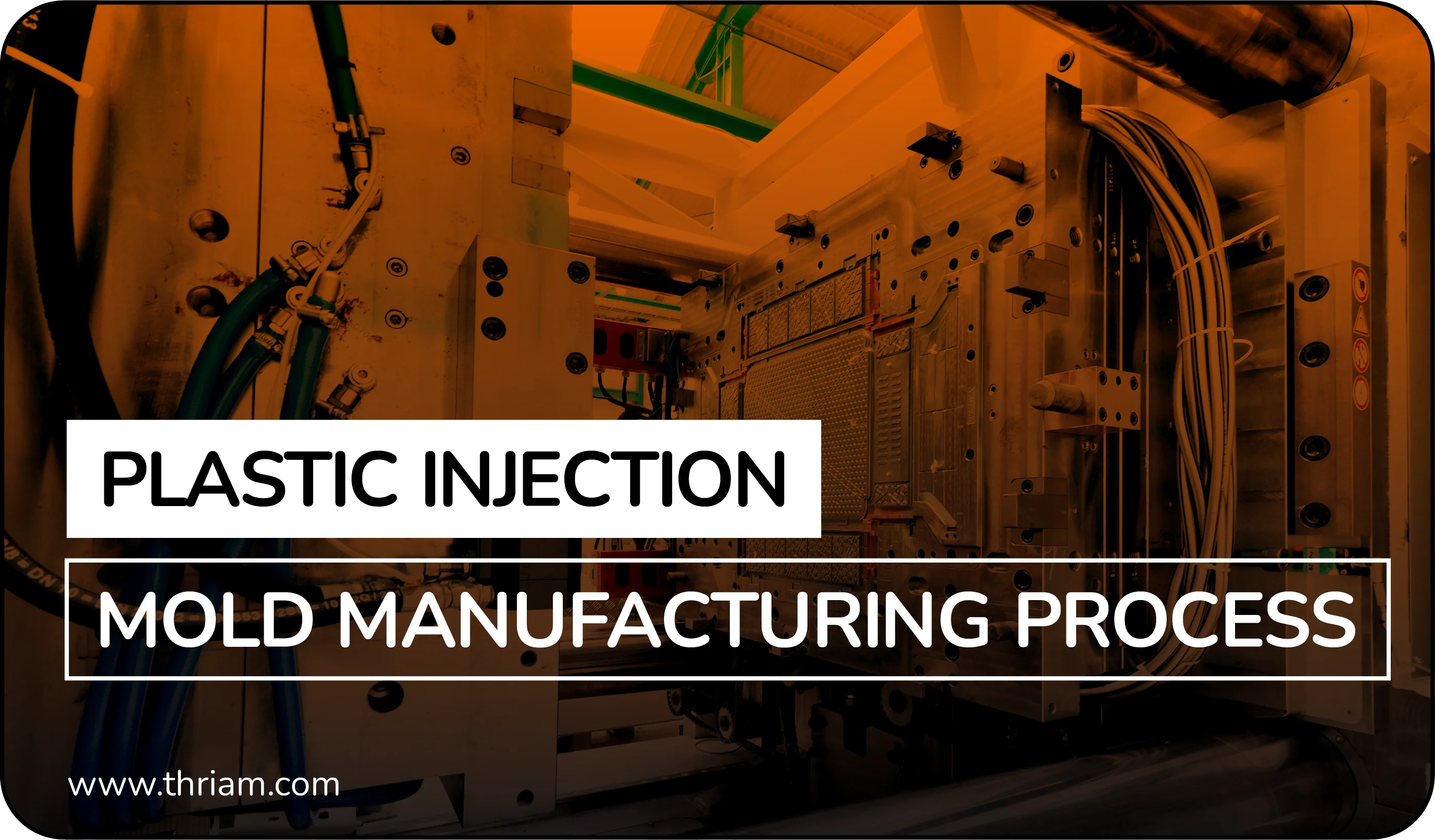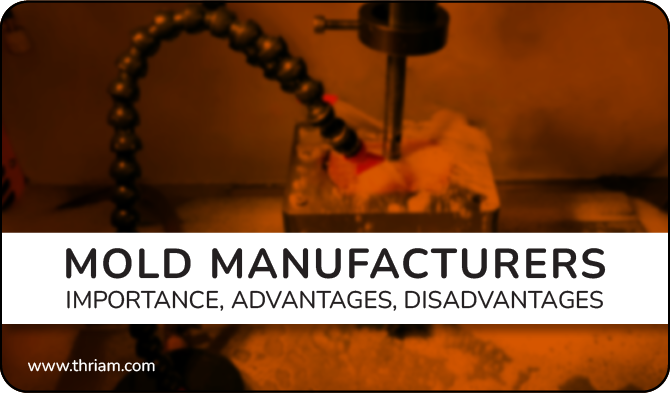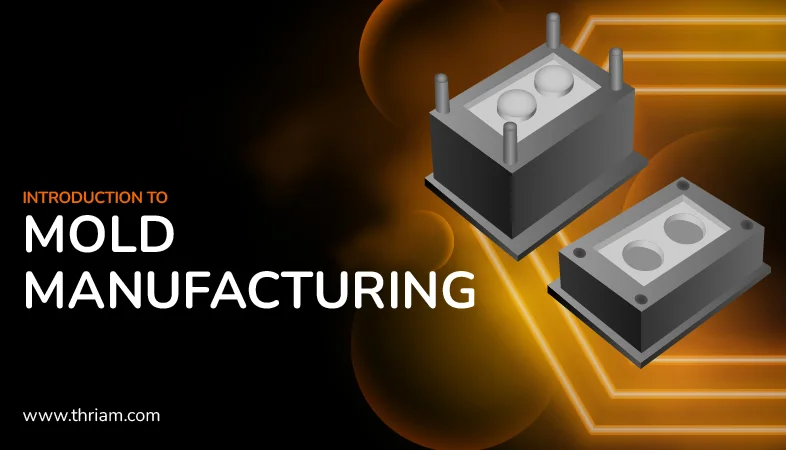The Art of Injection Mold Design: A Comprehensive Guide
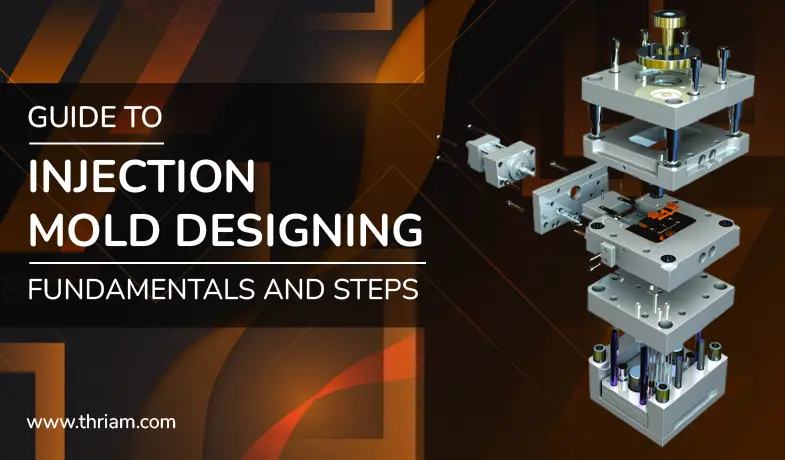
What is injection mold?
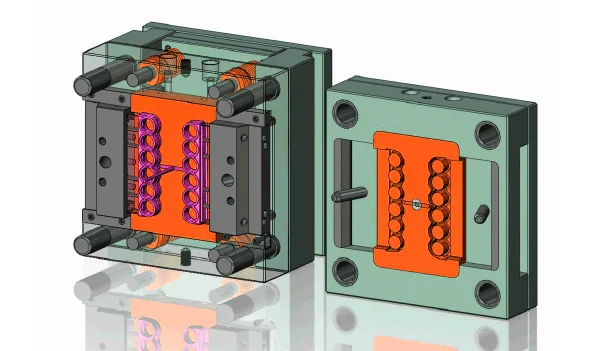
Injection molding is a widely used manufacturing process, and at the heart of this process lies the injection mold. So, what exactly is an injection mold?
Put simply, an injection mold is a tool that is used to shape plastic materials into a desired form. It consists of two main halves, the mold cavity and the mold core, which fit together to form a hollow space where the molten plastic is injected. This molten plastic then takes the shape of the mold cavity and cools down to solidify, resulting in a final plastic product.
The injection mold itself is precision-engineered to meet the specific requirements of the desired part. It is typically made from high-quality steel or aluminum and undergoes a meticulous design process to ensure accuracy and longevity. The mold design incorporates features such as slides, cores, and ejector systems to enable the production of complex shapes and details.
The injection molding process begins with the preparation of the mold. The plastic material, usually in the form of pellets, is heated to a molten state and then injected into the mold cavity under high pressure. The molten plastic fills the entire cavity, taking on the shape of the mold. Once the plastic has cooled and solidified, the mold is opened, and the part is ejected, ready for further processing or assembly.
Injection molds offer numerous advantages in modern manufacturing. They are capable of producing high volumes of identical parts with excellent precision and repeatability. The ability to create complex shapes, intricate details, and precise dimensions makes injection molding a highly versatile manufacturing method. Additionally, injection molding allows for a wide range of plastic materials to be used, including thermoplastics and thermosetting polymers.
Furthermore, injection molds are designed for longevity and durability. They are built to withstand high pressures and temperatures while maintaining dimensional accuracy over repeated cycles. With proper maintenance and care, an injection mold can last for thousands or even millions of cycles, making it a cost-effective solution for mass production.
Injection molding finds its applications in various industries, including automotive, consumer goods, electronics, medical devices, and more. It is used to produce a wide range of products, from intricate components and small parts to large industrial pieces.
What is injection mold designing?
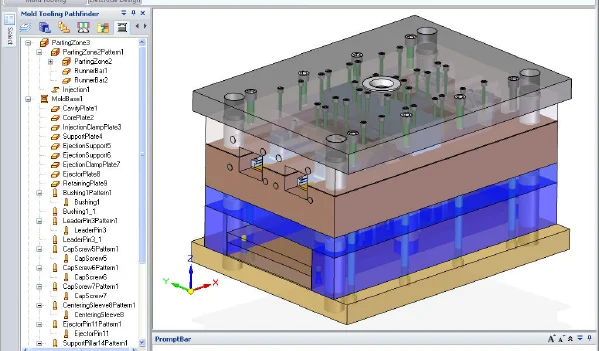
Injection mold design plays a critical role in the manufacturing process, laying the foundation for the creation of high-quality plastic components and products. But what exactly does injection mold design mean?
Injection mold design refers to the meticulous process of creating a blueprint or plan for the construction of a mold used in injection molding. It involves the careful consideration of various factors, including part geometry, material properties, functionality, manufacturing processes, and more.
At its core, injection mold design aims to achieve two primary objectives: to accurately capture the desired part geometry and to ensure the efficient and effective production of that part. Achieving these objectives requires expertise in multiple areas, including engineering, material science, and manufacturing techniques.
The injection mold design process typically begins with a thorough understanding of the part requirements. Designers carefully analyze the part geometry, dimensional tolerances, and surface finishes to determine the best approach for creating the mold. They must also consider the specific material properties and processing characteristics to ensure compatibility between the material and the mold.
Using specialized computer-aided design (CAD) software, designers develop a digital representation of the mold, incorporating all necessary details such as mold cavities, slides, cores, cooling channels, and ejector systems. The precise configuration of these elements is crucial for achieving the desired part characteristics and optimizing the injection molding process.
During the design phase, designers must also consider the manufacturing processes that will be involved in creating the mold. From machining and EDM (Electrical Discharge Machining) to CNC programming and surface treatments, each step must be carefully planned to ensure accurate and efficient mold production.
Additionally, injection mold design encompasses considerations for ongoing maintenance and future modifications. By incorporating features such as replaceable components and modular designs, designers can simplify mold repairs and facilitate any necessary changes or enhancements.
Successful injection mold design requires collaboration and clear communication between designers, part manufacturers, and mold makers. By engaging in a iterative feedback process, designers can refine their designs based on input from various stakeholders, ensuring that the final mold meets all requirements for functionality, manufacturability, and cost-effectiveness.
Basic fundamentals of injection mold designing
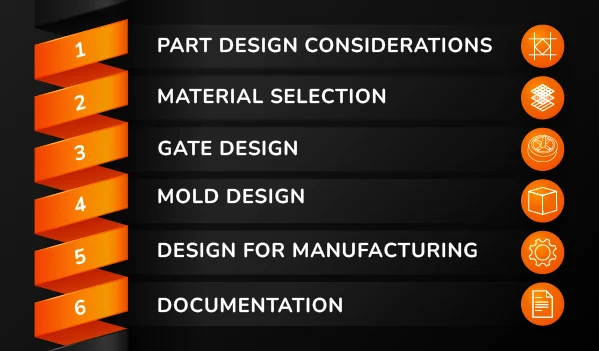
Injection mold design is a crucial aspect of injection molding, determining the quality, efficiency, and repeatability of the production process. Understanding the basic fundamentals of injection mold designing is essential to achieving high-quality plastic components and products.
Part Design Considerations
Injection mold design begins with the part requirements. Designers carefully analyze the part geometry, dimensional tolerances, and surface finishes to determine the best approach for creating the mold. The part geometry should be under the confines of the machine clamp to ensure it is moldable, and the draft angles must be correct to enable easy ejection of the part.
Material Selection
Material selection is a crucial aspect of injection mold design. The material properties, such as viscosity and thermal conductivity, impact the mold design, such as cooling channels, mold temperature, and injection pressure. Designers must consider the melting point, shrinkage, and warpage characteristics of the material to develop an effective mold design.
Gate Design
The gate design is crucial for the successful production of an injection molded part. The gate is the point where the molten plastic enters the mold cavity and sets the stage for the filling process. The gate size needs to be appropriate based on the product type, material properties, and injection pressure, and its location should be optimized for ease of removal.
Mold Design
Mold design includes elements such as the number of cavities, runners, cooling systems, parting line determination, and ejection. These elements contribute significantly to the quality and efficiency of the injection molding process. The balance of filling, packing pressure, and cooling are crucial elements that need consideration while designing the mold.
Design for Manufacturing
Designers must consider the manufacturing process in the mold design process. Features such as undercuts, threads, and snap-fits can be challenging to produce unless they are carefully designed and implemented. Including part-specific projections, chamfers, ribs, and alignment features in the mold can ease the production and improve the performance of the component.
Documentation
Injection mold design should not stop with the creation of the mold. Comprehensive documentation, including 2D/3D drawings, bill of materials, maintenance and repair guidelines, and safety procedures, is crucial for ensuring efficient communication and easy navigation of the mold's life cycle. Regular updates to the documentation ensure it remains accurate and up-to-date.
Types of softwares used in injection mold designing
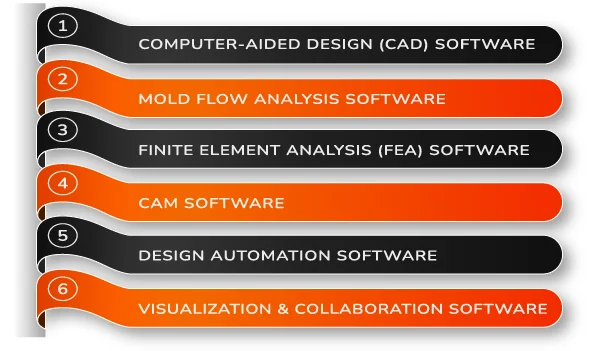
Software plays a crucial role in the design and development of injection molds. With the advancement in technology, various software solutions are available that aid in optimizing the mold design process, improving efficiency, and ensuring high-quality plastic components.
-
Computer-Aided Design (CAD) Software:
CAD software is the foundation of mold design. It allows designers to create detailed 3D models of the mold components, such as cavities, cores, slides, and cooling channels. CAD software provides tools for precise modeling, assembly creation, and visualization. Some popular CAD software options for mold design include SolidWorks, Autodesk Inventor, CATIA, and Siemens NX. -
Mold Flow Analysis Software:
Mold flow analysis software simulates the flow of molten plastic inside the mold cavity. It helps in predicting potential issues such as air traps, weld lines, sink marks, and warpage. By simulating the injection molding process, designers can optimize mold design, gate locations, and cooling strategies. Mold flow analysis software offers valuable insights into part and mold design optimization. Moldflow, Moldex3D, and Simpoe are commonly used software solutions for mold flow analysis. -
Finite Element Analysis (FEA) Software:
FEA software is utilized to analyze the structural integrity and performance of injection molds. It helps to identify potential weak points, stress concentration areas, deformation, and fatigue analysis. By simulating the reaction forces during the injection process, FEA software aids in optimizing mold design for improved durability and longevity. Software like ANSYS, Abaqus, and MSC Nastran are commonly used for FEA analysis. -
CAM Software:
Computer-Aided Manufacturing (CAM) software is used to generate tool paths for machining operations. CAM software takes the CAD model of the mold and generates efficient tool paths for CNC machines. It helps in automating complex machining operations, reducing lead times, and improving accuracy. Popular CAM software for mold design includes Mastercam, PowerMill, and NX CAM. -
Design Automation Software:
Design automation software allows for the automation of repetitive tasks in mold design. It helps in generating standard mold components, standardizing processes, and reducing design time. Design automation software enables designers to create customizable templates, libraries, and catalogs for quick and accurate mold design. Autodesk Configurator 360 and Tacton Design Automation are examples of design automation software. -
Visualization and Collaboration Software:
Visualization and collaboration software tools help in effectively communicating and collaborating with stakeholders involved in the mold design process. These tools enable real-time collaboration, markups, and annotations to facilitate clear communication between designers, engineers, and manufacturers. Examples of such software include Dassault Systemes' 3DEXPERIENCE platform, Autodesk Fusion 360, and Siemens Teamcenter.
Steps to follow when designing an injection mold
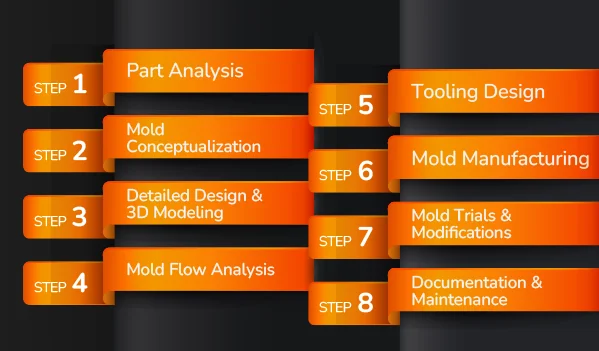
Step 1: Part Analysis
The first step in injection mold design is to thoroughly analyze the part requirements. This involves examining the part geometry, dimensional tolerances, surface finishes, and material properties. Understanding these aspects helps determine the best approach for creating the mold.
Step 2: Mold Conceptualization
Once the part requirements have been analyzed, the next step is to create a mold concept. This involves determining the number of cavities required, the mold configuration, and the overall layout of the mold. Considerations such as parting lines, runners, gates, and ejection systems are made during this stage.
Step 3: Detailed Design and 3D Modeling
After the mold concept has been established, the detailed design process begins. Using specialized computer-aided design (CAD) software, designers create a 3D model of the mold. The 3D model includes all the necessary components like cavities, cores, ejector systems, cooling channels, and any other specific features required for the mold.
Step 4: Mold Flow Analysis
Mold flow analysis is a crucial step in the mold design process. It involves simulating the flow of molten plastic through the mold to identify any potential issues or challenges. Mold flow analysis helps optimize the mold design, ensuring proper filling, minimizing shrinkage, and reducing any defects in the final product.
Step 5: Tooling Design
Based on the detailed design and mold flow analysis, the tooling design stage begins. This involves designing the mold's individual components, such as the core, cavity, and inserts. The tooling design also includes considerations for ejector systems, cooling channels, and any necessary slides or lifters.
Step 6: Mold Manufacturing
Once the tooling design is complete, the mold manufacturing process begins. Skilled mold makers use specialized machining techniques, such as CNC milling, EDM, and grinding, to manufacture the mold components with precision. The mold is then assembled, polished, and tested to ensure proper functionality.
Step 7: Mold Trials and Modifications
After the mold is manufactured, it undergoes a series of trials to evaluate its performance. Mold trials involve injecting molten plastic into the mold and assessing the quality of the produced parts. If any issues or improvements are identified, modifications may be made to the mold design to address them.
Step 8: Documentation and Maintenance
Finally, comprehensive documentation is created, including 2D/3D drawings, bill of materials, maintenance guidelines, and safety procedures. This documentation ensures effective communication and provides essential information for the maintenance and repair of the mold throughout its lifespan.
Conclusion:
The process of injection mold design is a complex and meticulous endeavor that requires careful planning, analysis, and utilization of various software tools. By following a systematic approach and considering factors such as part analysis, mold conceptualization, 3D modeling, mold flow analysis, tooling design, mold manufacturing, trials, and documentation, manufacturers can ensure the creation of high-quality molds capable of producing precise and durable plastic components.
Moreover, the use of software tools such as CAD, mold flow analysis, FEA, CAM, design automation, and visualization and collaboration software greatly enhances efficiency, accuracy, and collaboration throughout the mold design process. By leveraging these advanced technologies and best practices, manufacturers can optimize the injection mold design process, reduce lead times, and successfully bring their plastic component designs to life.
